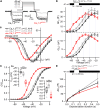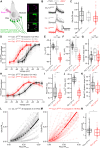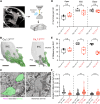Gating of hair cell Ca2+ channels governs the activity of cochlear neurons
- PMID: 40532010
- PMCID: PMC12225641
- DOI: 10.1126/sciadv.adu7898
Gating of hair cell Ca2+ channels governs the activity of cochlear neurons
Abstract
Our sense of hearing processes sound intensities spanning six orders of magnitude. In the ear, the receptor potential of presynaptic inner hair cells (IHCs) covers the entire intensity range, while postsynaptic spiral ganglion neurons (SGNs) tile the range with their firing rate codes. IHCs vary the voltage dependence of Ca2+ channel activation among their active zones (AZs), potentially diversifying SGN firing. Here, we tested this hypothesis in mice modeling the human CaV1.3A749G mutation that causes low-voltage Ca2+ channel activation. We demonstrate activation of Ca2+ influx and glutamate release of IHC AZs at lower voltages, increased spontaneous firing in SGNs, and lower sound threshold of CaV1.3A749G/A749G mice. Loss of synaptic ribbons in IHCs at ambient sound levels of mouse husbandry indicates that low-voltage Ca2+ channel activation poses a risk for noise-induced synaptic damage. We propose that the heterogeneous voltage dependence of CaV1.3 activation among presynaptic IHC AZs contributes to the diversity of firing among the postsynaptic SGNs.
Figures






Similar articles
-
Genetic, cellular, and functional evidence for Ca2+ inflow through Cav1.2 and Cav1.3 channels in murine spiral ganglion neurons.J Neurosci. 2014 May 21;34(21):7383-93. doi: 10.1523/JNEUROSCI.5416-13.2014. J Neurosci. 2014. PMID: 24849370 Free PMC article.
-
Bridging the gap between presynaptic hair cell function and neural sound encoding.Elife. 2024 Dec 24;12:RP93749. doi: 10.7554/eLife.93749. Elife. 2024. PMID: 39718472 Free PMC article.
-
Pou4f1 Defines a Subgroup of Type I Spiral Ganglion Neurons and Is Necessary for Normal Inner Hair Cell Presynaptic Ca2+ Signaling.J Neurosci. 2019 Jul 3;39(27):5284-5298. doi: 10.1523/JNEUROSCI.2728-18.2019. Epub 2019 May 13. J Neurosci. 2019. PMID: 31085606 Free PMC article.
-
Diversity matters - extending sound intensity coding by inner hair cells via heterogeneous synapses.EMBO J. 2023 Dec 1;42(23):e114587. doi: 10.15252/embj.2023114587. Epub 2023 Oct 6. EMBO J. 2023. PMID: 37800695 Free PMC article. Review.
-
Recent advances in the development and function of type II spiral ganglion neurons in the mammalian inner ear.Semin Cell Dev Biol. 2017 May;65:80-87. doi: 10.1016/j.semcdb.2016.09.017. Epub 2016 Oct 17. Semin Cell Dev Biol. 2017. PMID: 27760385 Free PMC article. Review.
References
-
- B. R. Shrestha, L. V. Goodrich, “Wiring the cochlea for sound perception” in The Oxford Handbook of the Auditory Brainstem, K. Kandler, Ed. (Oxford Univ. Press, 2019).
-
- Platzer J., Engel J., Schrott-Fischer A., Stephan K., Bova S., Chen H., Zheng H., Striessnig J., Congenital deafness and sinoatrial node dysfunction in mice lacking class D L-type Ca2+ channels. Cell 102, 89–97 (2000). - PubMed
MeSH terms
Substances
LinkOut - more resources
Full Text Sources
Miscellaneous

